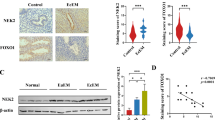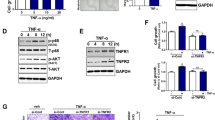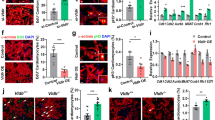Abstract
Uterine leiomyoma is characterized by abundant extracellular matrix and broad avascular areas, both constantly resulting in hypoxia, suggesting some hypoxia-induced response function. Here, we examined whether hypoxia-inducible factor 1α (HIF-1α)-mediated hypoxic response function in uterine leiomyoma. Immunoblotting detected higher basal HIF-1α protein expression in nuclear extracts from uterine leiomyoma tissues than in those from the adjacent myometrium (P =.0011). Immunohistochemical analysis revealed the presence of HIF-1α-positive cellular components in both leiomyoma and surrounding myometrial tissues. Hypoxia decreased HIF-1α messenger RNA (mRNA), but increased HIF-1α protein in primary culture leiomyoma smooth muscle cells, and caused translocation of HIF-1α from the cytoplasm to the nucleus. Hypoxia upregulated mRNAs of 6 potential HIF-responsive genes (ALDOA, ENO1, LDHA, VEGFA, PFKFB3, and SLC2A1). Chromatin immunoprecipitation quantitative polymerase chain reaction revealed that hypoxia significantly increased recruitment of HIF-1α binding to putative HIF-responsive elements in the HIF-responsive genes, suggesting that the HIF transcriptional complex initiates hypoxia-induced transcription of HIF-responsive genes. These results demonstrated a HIF-1α-mediated hypoxic response in uterine leiomyoma.
Similar content being viewed by others
References
Sozen I, Arici A. Interactions of cytokines, growth factors, and the extracellular matrix in the cellular biology of uterine leiomyomata. Fertil Steril. 2002;78(1):1–12.
Mayer A, Hockel M, Wree A, Leo C, Horn LC, Vaupel P. Lack of hypoxic response in uterine leiomyomas despite severe tissue hypoxia. Cancer Res. 2008;68(12):4719–4726.
Semenza GL. HIF-1 mediates metabolic responses to intratumoral hypoxia and oncogenic mutations. J Clin Invest. 2013;123(9):3664–3671.
Luo D, Wang Z, Wu J, Jiang C, Wu J. The role of hypoxia inducible factor-1 in hepatocellular carcinoma. Biomed Res Int. 2014;2014:409272.
Palazon A, Goldrath AW, Nizet V, Johnson RS. HIF transcription factors, inflammation, and immunity. Immunity. 2014;41(4):518–528.
Pawlus MR, Hu CJ. Enhanceosomes as integrators of hypoxia inducible factor (HIF) and other transcription factors in the hypoxic transcriptional response. Cell Signal. 2013;25(9):1895–1903.
Hou P, Zhao L, Li Y, et al. Comparative expression of thioredoxin-1 in uterine leiomyomas and myometrium. Mol Hum Reprod. 2014;20(2):148–154.
Wei JJ, Zhang XM, Chiriboga L, Yee H, Perle MA, Mittal K. Spatial differences in biologic activity of large uterine leiomyomata. Fertil Steril. 2006;85(1):179–187.
Mayer A, Hoeckel M, von Wallbrunn A, Horn LC, Wree A, Vaupel P. HIF-mediated hypoxic response is missing in severely hypoxic uterine leiomyomas. Adv Exp Med Biol. 2010; 662:399–405.
Shozu M, Sumitani H, Segawa T, et al. Overexpression of aromatase P450 in leiomyoma tissue is driven primarily through promoter I.4 of the aromatase P450 gene (CYP19). J Clin Endocrinol Metab. 2002;87(6):2540–2548.
Sumitani H, Shozu M, Segawa T, Yang HJ, Murakami K, Inoue M. In situ estrogen synthesized by aromatase P450 in uterine leiomyoma cells promotes cell growth probably via an autocrine/intracrine mechanism. Endocrinology. 2000;141(10):3852–3861.
Yuan Y, Hilliard G, Ferguson T, Millhorn DE. Cobalt inhibits the interaction between hypoxia-inducible factor-alpha and von Hippel-Lindau protein by direct binding to hypoxia-inducible factor-alpha. J Biol Chem. 2003;278(18):15911–15916.
Wang G, Ishikawa H, Sone K, et al. Nonobese diabetic/severe combined immunodeficient murine xenograft model for human uterine leiomyoma. Fertil Steril. 2014;101(5):1485–1492.
Semenza GL, Jiang BH, Leung SW, et al. Hypoxia response elements in the aldolase A, enolase 1, and lactate dehydrogenase A gene promoters contain essential binding sites for hypoxia-inducible factor 1. J Biol Chem. 1996;271(51):32529–32537.
Hu J, Stiehl DP, Setzer C, et al. Interaction of HIF and USF signaling pathways in human genes flanked by hypoxia-response elements and E-box palindromes. Mol Cancer Res. 2011;9(11):1520–1536.
Walczak R, Joseph SB, Laffitte BA, Castrillo A, Pei L, Tontonoz P. Transcription of the vascular endothelial growth factor gene in macrophages is regulated by liver X receptors. J Biol Chem. 2004;279(11):9905–9911.
Rademakers SE, Span PN, Kaanders JH, Sweep FC, van der Kogel AJ, Bussink J. Molecular aspects of tumour hypoxia. Mol Oncol. 2008;2(1):41–53.
Samarajeewa NU, Yang F, Docanto MM, et al. HIF-1α stimulates aromatase expression driven by prostaglandin E2 in breast adipose stroma. Breast Cancer Res. 2013;15(2):R30.
Rankin EB, Giaccia AJ. The role of hypoxia-inducible factors in tumorigenesis. Cell Death Differ. 2008;15(4):678–685.
Galban S, Gorospe M. Factors interacting with HIF-1alpha mRNA: novel therapeutic targets. Curr Pharm Des. 2009;15(4):3853–3860.
Belaiba RS, Bonello S, Zähringer C, et al. Hypoxia up-regulates hypoxia-inducible factor-1alpha transcription by involving phosphatidylinositol 3-kinase and nuclear factor kappaB in pulmonary artery smooth muscle cells. Mol Biol Cell. 2007;18(2):4691–4697.
Sperandio S, Fortin J, Sasik R, Robitaille L, Corbeil J, de Belle I. The transcription factor Egr1 regulates the HIF-1alpha gene during hypoxia. Mol Carcinog. 2009;48(1):38–44.
Ishikawa H, Shozu M, Okada M, et al. Early growth response gene-1 plays a pivotal role in down-regulation of a cohort of genes in uterine leiomyoma. J Mol Endocrinol. 2007;39(5):333–341.
Mongiat M, Andreuzzi E, Tarticchio G, Paulitti A. Extracellular matrix, a hard player in angiogenesis. Int J Mol Sci. 2016;17(11): pii:E1822.
Tinelli A, Mynbaev OA, Sparic R, et al. Angiogenesis and vascularization of uterine leiomyoma: clinical value of pseudocapsule containing peptides and neurotransmitters. Curr Protein Pept Sci. 2017;18(2):129–139.
Gueye NA, Mead TJ, Koch CD, Biscotti CV, Falcone T, Apte SS. Versican proteolysis by ADAMTS proteases and its influence on sex steroid receptor expression in uterine leiomyoma. J Clin Endocrinol Metab. 2017;102(5):1631–1641.
Norian JM, Malik M, Parker CY, et al. Transforming growth factor beta3 regulates the versican variants in the extracellular matrix-rich uterine leiomyomas. Reprod Sci. 2009;16(12):1153–1164.
Koohestani F, Braundmeier AG, Mahdian A, Seo J, Bi J, Nowak RA. Extracellular matrix collagen alters cell proliferation and cell cycle progression of human uterine leiomyoma smooth muscle cells. PLoS One. 2013;8(9):e75844.
Chen HM, Lin YH, Cheng YM, Wing LY, Tsai SJ. Overexpression of integrin-beta1 in leiomyoma promotes cell spreading and proliferation. J Clin Endocrinol Metab. 2013;98(5):E837–E846.
Ban HS, Kim BK, Lee H, et al. The novel hypoxia-inducible factor-1alpha inhibitor IDF-11774 regulates cancer metabolism, thereby suppressing tumor growth. Cell Death Dis. 2017;8(6):e2843.
Cheloni G, Tanturli M, Tusa I, et al. Targeting chronic myeloid leukemia stem cells with the hypoxia-inducible factor inhibitor acriflavine. Blood. 2017;130(5):655–665.
Zhu Y, Zang Y, Zhao F, et al. Inhibition of HIF-1alpha by PX-478 suppresses tumor growth of esophageal squamous cell cancer in vitro and in vivo. Am J Cancer Res. 2017;7(5):1198–1212.
Author information
Authors and Affiliations
Corresponding author
Additional information
Authors’ Note
This study was conducted in the Department of Reproductive Medicine, Graduate School of Medicine, Chiba University.
Rights and permissions
About this article
Cite this article
Ishikawa, H., Xu, L., Sone, K. et al. Hypoxia Induces Hypoxia-Inducible Factor 1α and Potential HIF-Responsive Gene Expression in Uterine Leiomyoma. Reprod. Sci. 26, 428–435 (2019). https://doi.org/10.1177/1933719118776793
Published:
Issue Date:
DOI: https://doi.org/10.1177/1933719118776793




